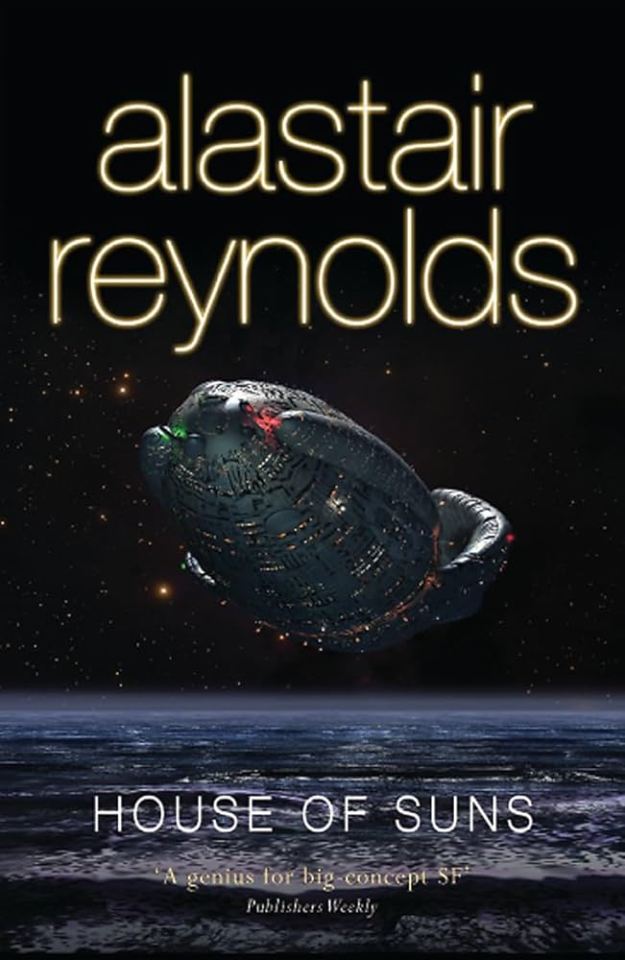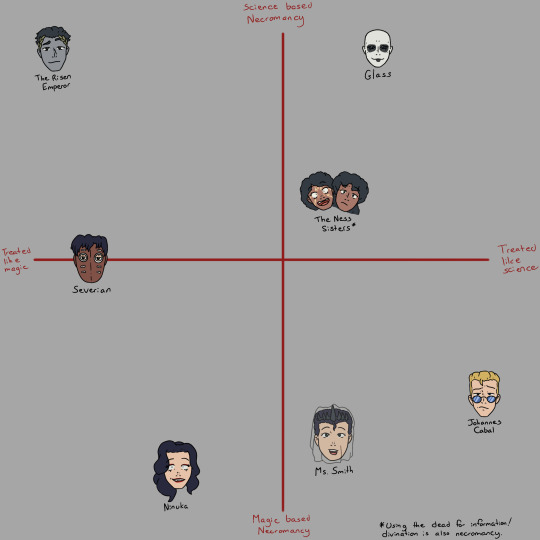#alastair reynolds
Explore tagged Tumblr posts
Text
Botanic Tournament : Main Bracket !
Round 1 Poll HHH



(Gentian)
#botanic tournament#tournament polls#round 1#abigail gentian#house of suns#sf#science fiction#alastair reynolds#bookblr#piranha plant#mario bros.#super mario bros#mario bros#super mario#mario#nintendo#gameblr
144 notes
·
View notes
Text
I've on occasion said that the best sort of spaceship is one that acts as a shared house for 3 to 10 ish weirdoes to find found family in, plus all the usual spaceship gubbins
vaguely gesturing in the direction of Ebon Hawks, Sereneties, Be Bops, Tempests, and the like
little ships, sorta in the 40-150m range
but there's nothing in that description that precludes multi-kilometre behemoths complete with generous cargo space, an extensive cache of WMDs, and an onboard arboretum
the crew on the other hand
23 notes
·
View notes
Text
Hey @doppelgangerleaverite I made a compilation of tweets that encapsulate how I feel about Sky Haussmann






#sky haussman#sky haussmann#revelation space#im so normal about this character#its weird cuz i dont want to fuck him at all.#i want to study him#psybreposting#chasm city#alastair reynolds
10 notes
·
View notes
Text

Some very silly crossover doodling for Trigun and Terminal World.
Got to love those sci-fi westerns set on dying worlds that have something deeply unsettling about how they work.
#trigun#terminal world#vash the stampede#nicholas d. wolfwood#meryl stryfe#milly thompson#alastair reynolds#quillon#meroka
20 notes
·
View notes
Text
If you ever find yourself in an Alastair Reynolds novel: try transitioning.
It will increase your survival odds from ~3% to as high as 25%.
#alastair reynolds#revelation space#terminal world#I forget what the survival rates were like in other books#some stories let more people live (like the Prefect series)
24 notes
·
View notes
Text
The Doctor kept an eye on the Master as the Praxilions readied the craft for flight. He remained comatose, breathing slowly but re-gularly. As vulnerable, in his way, as when he had been inside the Infinite Cocoon.
‘If our positions were reversed,' the Doctor whispered, 'what would you do? Smother me? Something worse? Or accept that there's a part of me in you, a part of you in me?'
Alastair Reynolds, Doctor Who - The Harvest of Time
#third doctor#the harvest of time#alastair reynolds#the master#thoschei#master x doctor#jon pertwee#Roger Delgado#doctor who#dw#ridoctorwho#quotes#thoschei in their toxic yuri era/j#koschei#theta sigma
33 notes
·
View notes
Text

Bleak and disturbing science fiction reading list
A list of science fiction novels and short story collections with dark themes and gloomy settings. The selection includes dystopias, post-apocalyptic and climate fiction, as well as unsettling sci-fi horror. See the full list on my website for more titles and links to Goodreads and Wikipedia.
#dark books#book recs#book recommendations#reading list#book list#science fiction#sci fi#grimdark#peter watts#iain m banks#alastair reynolds#paolo bacigalupi#harlan ellison
109 notes
·
View notes
Text
“I think I've reduced the amount of blood in my caffeine system to an acceptable level.”
―��Alastair Reynolds, Revelation Space
14 notes
·
View notes
Text
So what's it going to be champ?
Demarchist, Conjoiner or Ultra?
7 notes
·
View notes
Text
Eversion, by Alastair Reynolds
Let's try reviewing a book, shall we?
I just finished "Eversion" by Alastair Reynolds, and I have thoughts.
Oh, and everything will be spoilers after the cut...
Dr Silas Coade is the physician aboard the sailship Demeter, which is venturing north to investigate a mystery.
No, Dr Silas Coade is the physician aboard the steamship Demeter, which is sailing south to investigate a mystery in deepest Patagonia.
But no, no, Dr Silas Coade is the physician aboard the airship Demeter, which is shortly due to enter a fissure into the Hollow Earth to investigate a mystery far below the surface of the not-entirely-physically-plausible bauble-planet...
But no, no, no ... this isn't it, is it SILAS? You need to wake up before time runs out, entombed here below the ice-crust on Jupiter's moon Europa - Silas? Silas are you listening? Silas are we about to do this again, and what do you mean Dupin hasn't solved the eversion problem yet -
Cut
As quickly becomes apparent, Silas is apparently stuck in some sort of fantastical loop. Said loop appears to be linked to a story that he is attempting to write, in all iterations of it. The structure of the setting varies - the technology level goes up over each loop, but the nature of each loop is less plausible than the one preceding it. The very first loop is something that could believably have happened. The second loop is starting to stretch things a little - how did this crappy ship get all the way down to Patagonia? - but it's not quite jumped the shark, at least not yet. While it's subtle, the behaviour of gravity inside the Hollow Earth is wrong (there shouldn't be a "down" inside a uniform self-gravitating hollow spehere). Oh, and the shell-planet is also self-evidently absurd, though no-one living there sees it as such. The last, and obviously-delusional, loop is straight out of a '40s SF pulp magazine. (In fact it bore more than a passing resemblance to bits of Triplanetary Patrol by E.E. 'Doc' Smith, which I'm pretty sure was deliberate on the part of the author!)
There are several common features to each loop. Silas is always the ship's physician. Ramos has always suffered some manner of head injury. The Demeter, whatever class of vehicle it is, is always voyaging toward a mysterious destination that can only be reached through a fissure, though the nature of the fissure changes each time. In each stage, Dupin, the young mathematician, is always ill and is always working on a problem related to the concept of "eversion". Dupin's condition also progresses - he visibily deteriorates between each cycle, even though the delusions themselves reset. When the Demeter traverses the fissure, they find a bizarre, menacing construction called the Edifice, which appears to be of inhuman origin and whose purpose is not clear. They also find the wreck of another ship, the Europa, which apparently got there first. The crew of the Demeter discover they have been lied to. Disaster swiftly follows, ending with Silas's death.
Interestingly, in every cycle Silas has experienced some form of psychotropic disorder. Usually this presents as an addiction, which he is hiding from the crew (laudanum, then morphine, then the "Radium draught" from the Hollow Earth episode), though later on it takes the form of a supposed indoctrinal machine called the Plastic Educator. It is clear from these episodes that Silas does not have the full facts of his situation - or, perhaps, is hiding from them - though what exactly the real problem is remains unclear.
Also, there is always lightning.
Enter Ada Cossile. The mysterious woman is not present in absolutely every iteration of the cycle - she's notably absent aboard the Interplanetary Patrol spaceship - but when she is present, she acts both as a critic and somewhat of a temptress-figure to Silas. She critiques his writing, often quite harshly, but she also implies (or outright states) that the world that Silas occupies is a lie. She seems to know more than she should.
It slowly emerges that Cossile is trying to draw Silas back to reality, or at least what she views as reality. They are indeed on board a vehicle called the Demeter, except it is actually a lander from a spacecraft, currently trapped below the ice on Jupiter's moon Europa. It is close to an alien artifact known as the Edifice, and there is another wrecked ship - also called the Europa - nearby, as it appears that a second expedition was launched without the knowledge of Demeter's crew. Also, the crews of both have been abducted and are now trapped inside the Edifice, which is stated to be slowly mind-draining them toward death, and it's up to Ada and Silas to save them.
But the reality of the situation is simply too much, and Silas keeps fleeing from it into a hallucinatory fugue-state.
These are not the only revelations, though I have deliberately not mentioned a few points, so as not to spoil every surprise :)
Eversion is a page-turner - I found it hard to put down. The underlying mystery is interesting, and it poses some hard questions about loss and sacrifice - how much sacrifice is justified to save others? As is often the case with Reynolds novels, there's a theme of forbidden knowledge. It would have been better for everybody if they'd simply ignored the Edifice in the first place and no expedition to Jupiter had ever been launched. When Silas learns the truth, it doesn't make him happy, and in fact he's at his happiest at the very end when he abandons reality for the final time and goes to live permanently in what's implied to be his final fugue-state.
There are also - possibly - some unanswered questions. I'm not 100% convinced we've had the entire truth about who or what Ada Cossile was. There could be some hints that she too either does not know the full facts of her situation, or is presenting an edited version. There's one, brief scene in which Silas perceives her as something monstrous rather than alluring. Also, she's very keen that someone has to remain behind inside the Edifice and she's also very keen for the eversion problem to be solved - and who else might be interested in both these outcomes? After all, the eversion seems to be linked to whatever process via which the Edifice became damaged in the first place - a solution to the eversion could also be beneficial for the Edifice. One can wonder if perhaps it realised that the escape of some of its prisoners was inevitable, so instead it devised a "controlled crash" scenario where it's still able to get at least some of what it wants. (Dupin remains entombed within, and the Edifice has control of the wrecks of both the Europa and the Demeter. And with eversion solved, perhaps it can heal itself.) In this model, one has to wonder whether perhaps Ada has been influenced by the Edifice, or may indeed be an avatar of it? It's interesting that Silas seems to keep feeling a need to flee from her, even while he remains fascinated by her - perhaps on some level, he's sensed that something is "off" about her. It's also notable that Ada has a colour-motif associated with her - yellow! - and this is in a novel that is not generally heavy on strong visual imagery. (I also find myself reminded of the famous King In Yellow, a well-known proto-Lovecraftian work, though perhaps this might be a bit of a reach.)
Anyway, none of this is proved - perhaps Ada's story actually is the truth! - though I think a case can be made for it.
Overall I'd say that Eversion is an interesting, challenging novel, and definitely one worth reading.
4 notes
·
View notes
Text
I found The Expanse (the first time) while also reading Blue Remembered Earth by Alastair Reynold. I am so into space opera's and having my brain broken by science and technology. Their compatible. Yay Space! I could go on but there just so good.
Alastair Reynold has lots and lots of good books but Blue Remembered Earth is the most accessible one.
2 notes
·
View notes
Text
Botanic Tournament : Main Bracket !
Round 2 Poll NNN




(Gentians and carrots)
#botanic tournament#tournament polls#round 2#abigail gentian#house of suns#alastair reynolds#bookblr#science fiction#fantasy#terry pratchett#discworld#ankh morpork city watch#ankh morpork#carrot ironfoundersson
27 notes
·
View notes
Text
April 2023 Audio and eBook Deals!
We have some DEALS! CHEAP BOOKS! Roll up, roll up!
🎧Audible UK🎧
Price Deals!
The Tombs of Atuan, Ursula K. Le Guin - £2.99 between 16th and 22nd April
20th Century Ghosts (containing 'The Black Phone'), Joe Hill - £2.99 between 16th and 22nd April
2-for-1 - 6th-15th April
Red Country, Joe Abercrombie
Altered Carbon, Richard Morgan
Revenger, Alastair Reynolds
2-for-1 - 23rd-30th April
The Tower of the Swallow, Andrzej Sapkowski & David French
📚Kindle UK����
99p titles ALL MONTH
A Wizard of Earthsea (Earthsea 1), Ursula K. Le Guin
The Tombs of Atuan (Earthsea 2), Ursula K. Le Guin
The Left Hand of Darkness, Ursula K. Le Guin
The Dispossessed, Ursula K. Le Guin
Ubik, Philip K. Dick
The Fall of Hyperion, Dan Simmons
Elantris, Brandon Sanderson
Blood of Elves, Andrzej Sapkowski & Danusia Stok
Chronicles of the Black Company, Glen Cook
Permutation City, Greg Egan
The Blacktongue Thief, Christopher Buehlman
Lord Foul's Bane, Stephen Donaldson
Empire of Silence, Christopher Ruocchio
Halfway to the Grave, Jeaniene Frost
The Wise Man's Fear, Patrick Rothfuss
The Forever War, Joe Haldeman
99p titles between 17th-30th April
Against All Gods, Miles Cameron
The Last Unicorn, Peter S. Beagle
Blake's 7, Terry Nation
The This, Adam Roberts
Immortal Rising, Lynsay Sands
The Killing God, Stephen Donaldson
Seasparrow, Kristin Cashore
The Flight of the Aphrodite, S. J. Morden
🚨99p for JUST ONE DAY - 9th April!🚨
Ninth House, Leigh Bardugo

#Book discounts#Cheap Books#Kindle UK Deals#Audible UK Deals#Andrzej Sapkowski#The Witcher#Ursula K. Le Guin#Earthsea#The Last Unicorn#Peter S. Beagle#Joe Abercrombie#Brandon Sanderson#Miles Cameron#Richard Morgan#Ninth House#Leigh Bardugo#Adam Roberts#Lynsay Sands#Joe Haldemann#Alastair Reynolds#Joe Hill#Greg Egan#Philip K. Dick#Kristin Cashore#Graceling#Terry Nation#Blakes 7#Stephen Donaldson#Patrick Rothfuss#Kingkiller Chronicle
27 notes
·
View notes
Text
It sucks that there's no official visual representation of Sky Haussmann so I can't make a meme with his image + "I got 99 problems...and I caused all of them"
#my favoritest boy in the universe#easily in my top 5 cult leaders#sky haussman#sky haussmann#chasm city#revelation space#alastair reynolds#psybreposting
10 notes
·
View notes
Text

#the risen empire#johannes cabal#the book of the new sun#revelation space#just meme nonsense#revenger series#alastair reynolds
25 notes
·
View notes
Text
You’ve heard of:
Enemies to Lovers
You’ve probably heard of:
Enemies to Found Family
Now it’s time for:
Enemies to Headmates
89 notes
·
View notes